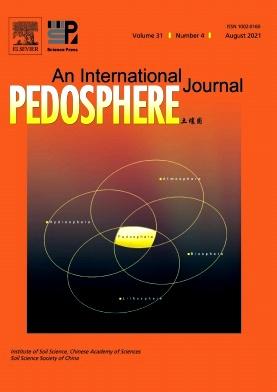腐植酸对土壤致病菌的潜在抑制作用研究进展
IF 7.3
2区 农林科学
Q1 SOIL SCIENCE
引用次数: 0
摘要
土传真菌病害绿色防治管理是农业、生态、环境等领域的研究热点。揭示功能物质的作用机制,开发高效的土壤改良剂,是有效防治土传真菌病害、解决连作障碍导致的土壤退化、实现农业可持续发展的重要途径。腐植酸对土传致病真菌尖孢镰刀菌、葫芦白霉、番茄根丝核菌等均有抑制作用,抑制率达80%以上。腐植酸的-COOH、酚C、甲氧基C、羧基C、芳香族C - o、头聚糖C等官能团的分子和元素组成及含量在以往的研究中被推断为腐植酸对病原真菌具有抑制作用的原因。抑制机制主要包括细胞生理形态、生化过程反应和分子信号转导。本文系统综述了腐植酸的化学结构、抑菌作用、变异特性及抑制机理,旨在为开发绿色高效的土传真菌病害防治技术提供理论依据。本文章由计算机程序翻译,如有差异,请以英文原文为准。
Potential inhibition of humic acid against soil-borne pathogenic fungi: A review
Green prevention and control management of soil-borne fungal diseases is a hot topic in agriculture, ecology, and the environment. It is an important way to effectively prevent and control soil-borne fungal diseases, solve soil degradation caused by continuous cropping obstacles, and fulfill the sustainable development of agriculture through revealing the mechanisms of functional substances to develop highly effective soil amendments. Humic acid shows an inhibitory effect on soil-borne pathogenic fungi, such as Fusarium oxysporum, Choanephora cucurbitarum, and Rhizoctonia solani, with the inhibition rate exceeding 80%. The molecular and elemental composition and contents of –COOH, phenolic C, methoxy group C, carboxyl C, aromatic C–O, anomeric C, and other functional groups of humic acid have been inferred to be responsible for its inhibitory effects on pathogenic fungi in previous research. The inhibitory mechanisms mainly include cell physiological morphology, biochemical process reactions, and molecular signal transduction. This review systematically summarizes the chemical structure, fungistatic effects, variable characteristics, and inhibitory mechanisms of humic acid, aiming to provide a theoretical basis for the development of green and efficient prevention and control technologies for soil-borne fungal diseases.
求助全文
通过发布文献求助,成功后即可免费获取论文全文。
去求助
来源期刊

Pedosphere
环境科学-土壤科学
CiteScore
11.70
自引率
1.80%
发文量
147
审稿时长
5.0 months
期刊介绍:
PEDOSPHERE—a peer-reviewed international journal published bimonthly in English—welcomes submissions from scientists around the world under a broad scope of topics relevant to timely, high quality original research findings, especially up-to-date achievements and advances in the entire field of soil science studies dealing with environmental science, ecology, agriculture, bioscience, geoscience, forestry, etc. It publishes mainly original research articles as well as some reviews, mini reviews, short communications and special issues.
 求助内容:
求助内容: 应助结果提醒方式:
应助结果提醒方式:


